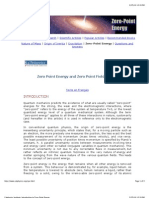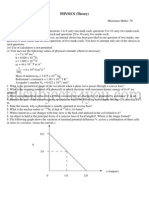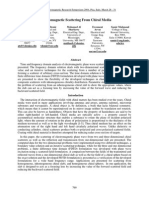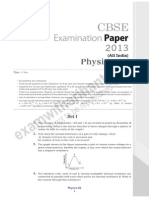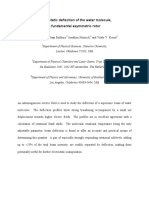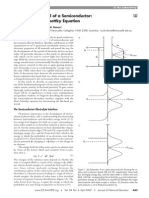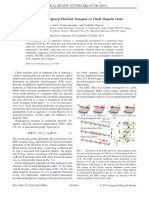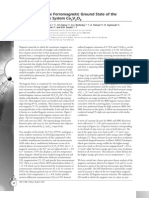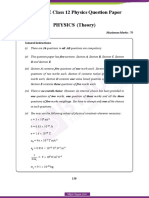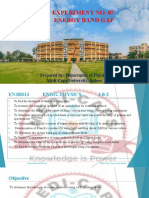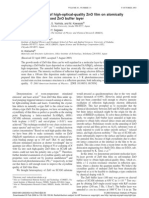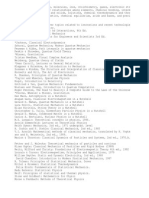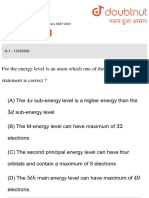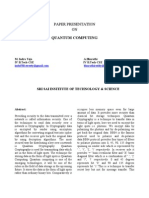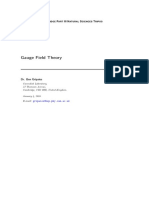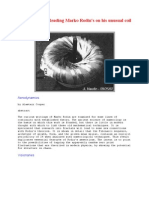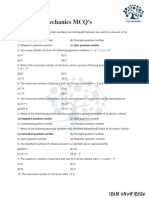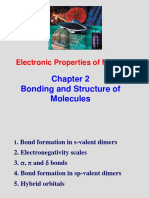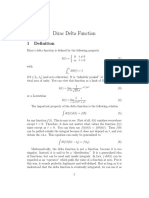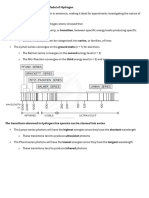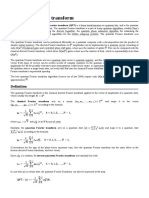JApplPhys 95 5498 PDF
JApplPhys 95 5498 PDF
Uploaded by
EidelsayedCopyright:
Available Formats
JApplPhys 95 5498 PDF
JApplPhys 95 5498 PDF
Uploaded by
EidelsayedOriginal Title
Copyright
Available Formats
Share this document
Did you find this document useful?
Is this content inappropriate?
Copyright:
Available Formats
JApplPhys 95 5498 PDF
JApplPhys 95 5498 PDF
Uploaded by
EidelsayedCopyright:
Available Formats
JOURNAL OF APPLIED PHYSICS
VOLUME 95, NUMBER 10
15 MAY 2004
Impact of the k-linear term on nonlinear optical response
of the C-exciton manifold in ZnO
K. Hazu,a) K. Torii,b) and T. Sotac)
Department of Electrical, Electronics, and Computer Engineering, Waseda University, Shinjuku,
Tokyo 169-8555, Japan
S. Adachid)
Department of Applied Physics, Hokkaido University, Kitaku, Sapporo 060-8628, Japan
SF. Chichibue)
Institute of Applied Physics, Graduate School of Pure and Applied Sciences, University of Tsukuba,
1-1-1 Tennodai, Tsukuba, Ibaraki 305-8573, Japan
G. Cantwell
Director of Research Zn-Technology, Inc. 910 Columbia St. Brea, California 92821
D. C. Reynolds and C. W. Litton
Materials and Manufacturing Directorate, Air Force Research Laboratory,
Wright-Patterson Air Force Base, Ohio 45433
Received 27 October 2003; accepted 27 February 2004
Time-integrated and spectrally resolved four-wave mixing FWM has been applied to study the
impact of the k-linear term on nonlinear optical response of the C-exciton manifold in ZnO. From
the excitation wavelength dependence of the FWM signal, we have found possible evidence that the
mixing of the 1 and 5L states leads to a three-branch excitonic polariton dispersion but the
oscillator strength transfer is small. The energy separation between the lower polariton branch and
the extra branch due to the k-linear term has been found to be 3.5 meV. In addition, a binding energy
of biexcitons consisting of two C excitons of 1.4 meV has been obtained. 2004 American
Institute of Physics. DOI: 10.1063/1.1710727
ing to circumstances.1,6 8 Since the conduction band belongs
to the irreducible representation of 7 , the irreducible representation of the ground state C-exciton manifold is 1 7
7 1 2 5 . Here 1 on the left hand side represents
the symmetry of the exciton envelope function. Excitons
with the 1 and 5 symmetry are dipole-allowed for the
electric field polarized parallel and perpendicular to the c
axis, i.e., E c and Ec, respectively. Polarized reflectance
spectra912 reveal that the C-exciton manifold is isolated
from B exciton (n1) one by about 38.8 meV and located
still in the band gap, while the C-exciton resonance energies
are close to the n2 resonance energy of the A and B excitons. The oscillator strength of the 1 exciton is much larger
than that of the 5 exciton. However, there is little knowledge about the impact of the k-linear term on nonlinear optical response of the C-exciton manifold and the binding energy of the biexciton consisting of two C-hole excitons,
XX CC .
Four-wave mixing FWM signals are known to reflect
the dynamics of many-body Coulomb correlations such as
biexciton and two-pair scattering continuum resonances even
in a low excitation limit. In addition, FWM signals are background free emission signals due to coherent polarization
and, thus, are much more sensitive to small energy splitting
in comparison with signals recorded by the linear spectroscopic method.13
In this article, we have experimentally studied timeintegrated and spectrally resolved FWM signals from the
I. INTRODUCTION
The intrinsic exciton transitions in hexagonal semiconductors show interesting properties. The optical properties
near the band gap are determined by three exciton species.
They arise from the threefold splitting of the highest valence
bands due to the crystal-field and spin-orbit interactions. The
three valence bands are called A-, B-, and C-valence bands
and the resultant excitons are A, B, and C excitons. For typical hexagonal semiconductors such as CdS and GaN, it is
known that the order of the valence bands is A- 9 , B- 7 ,
and C- 7 . 15
In zinc oxide ZnO, there is a consensus that the
C-valence band has 7 symmetry. The valence bands with
symmetry of 7 gives rise to a term linear in k in the dispersion relation for wave vector perpendicular to the c axis, i.e.,
kc. The k-linear term is known to lead to an extra dispersion curve in the excitonic polariton dispersion curve accorda
Electronic mail: kouji@moegi.waseda.jp
Present address: Institute of Industrial Science, University of Tokyo, Meguro, Tokyo 153-8505, Japan.
c
Also at: Integrative Bioscience and Biomedical Engineering, Graduate
School of Science and Engineering, Waseda University, Shinjuku,
Tokyo 169-8555, Japan; electronic mail: tkyksota@waseda.jp
d
Also at: CREST, Japan Science and Technology Agency.
e
Also at: NICP, ERATO, Japan Science and Technology Agency JST,
2-4-6 Fujimi, Chiyodaku, Tokyo 102-0071, Japan; Photodynamics Research Center, RIKEN Institute of Physical and Chemical Research,
Aoba, Sendai, Miyagi 980-0845, Japan.
b
0021-8979/2004/95(10)/5498/4/$22.00
5498
2004 American Institute of Physics
Downloaded 20 Feb 2006 to 130.158.130.96. Redistribution subject to AIP license or copyright, see http://jap.aip.org/jap/copyright.jsp
J. Appl. Phys., Vol. 95, No. 10, 15 May 2004
Hazu et al.
5499
C-exciton manifold in a bulk ZnO. FWM signals were measured from a 110 surface. From the dependence of FWM
signals on the excitation wavelength and the spectral decomposition analysis of them, we have found that the coupling
between the 1 state and 5L state leads to the three-branch
excitonic polariton dispersion for kc and E c but the oscillator strength transfer is small. The energy separation between the lower polariton branch and the extra one due to the
k-linear term has been found to be 3.5 meV. The binding
energy of the CC biexciton, XX CC , is found to be 1.4 meV.
II. EXPERIMENT
The sample studied herein was a c-face bulk ZnO crystal
grown by the seeded vapor transport method. The sample
size was 2 mm3 mm500 m. Sample characterization
by means of linear and nonlinear spectroscopy can be found
elsewhere.12,14 A frequency-doubled, mode-locked Ti:sapphire laser was used as an excitation source in FWM experiments. The fundamental laser produced pulses of 80 fs at
repetition rate of 80 MHz. The frequency-doubled output
was divided into two beams with equal intensity. These
pulses with wave vectors k1 and k2 , respectively, were superimposed on the sample surface at angle of 6. The FWM
was performed in the 2k2 k1 backward geometry using a
degenerate two-pulse configuration. The delay time 12 between the two incident pulses was defined to be positive
when the k1 pulse precedes the k2 pulse. FWM signals were
detected, time integrated and spectrally resolved, by a combination of a 0.35 m focal length monochromator with a
2400 grooves/mm grating and a multichannel charge coupled
device detector as a function of 12 . The spectral resolution
was about 0.45 meV. According to circumstances, signals
were recorded phase sensitively by a pin photodiode. The
excited exciton density was of the order of 1016 cm3 , which
was much smaller than the Mott density (51018 cm3 ).
Throughout the measurements, the sample was held in a
closed-cycle helium cryostat and its temperature was maintained to be T10 K. Signals were measured from a 110
cleaved surface, to satisfy the condition kic (i1,2). A
neutral density filter was used in recording signals because
the signal intensity due to the 1 exciton was very strong.
III. RESULTS AND DISCUSSION
Figure 1 shows the polarization dependence of FWM
signals in the time domain for kic (i1,2). The signals
have been measured by a pin photodiode with the central
excitation photon energy of 3.4181 eV. Polarization conditions are as follows. Solid curve labeled as 0:
(E1 c,E2 c), dot-dashed curve labeled as 0:
(E1c,E2c), dashed curve labeled as 90:
(E1 c,E2c), and dotted curve labeled as 90:
(E1c,E2 c). Note that the dashed curve and dot-dashed
curve are multiplied by a factor of 50 and 10, respectively.
The two data for 0 directly demonstrate that excitons
with 1 and 5 symmetry are involved in the C-exciton
manifold as predicted by group theory and difference of their
oscillator strength is very large. Figure 1 also shows the following interesting feature. For the case of 90, FWM
FIG. 1. Polarization dependence of FWM signals in the time domain at T
10 K. The central photon enrgy of excitation is 3.4181 eV. The wave
vectors k1 and k2 are perpendicular to the c axis. denotes an angle between E1 and E2 , i.e., the polarization vectors of the k1 and k2 pulses. Even
in the case of 90, FWM signals remain finite. The dashed curve and the
dot-dashed curve are multiplied by a factor of 50 and 10, respectively.
signals remain finite within experimental accuracy. Thus, we
may conclude that 1 and 5 excitons interact each other to
produce FWM signals though they are independently excited
with a time lag and they have extremely different oscillator
strength.
Figure 2 shows FWM spectra solid curves recorded for
colinear polarization condition of E1 c, E2 c, and 12
0.1 ps in varying the excitation wavelength. The polarization condition ensures that the 1 exciton is primarily
excited. The central photon energy is a 3.4234, b 3.4164,
and c 3.4136 eV. In panels ac, the relatively broad
FWM bands appear in the photon energy region where the
reflection spectrum polarized for kc and E c11,12 show a
large reflection structure assigned as the 1 exciton. When
the two-branch excitonic polariton model is applied as usual
to interpret the observed bands, the number of FWM emission bands appearing in the region ranging from the transverse (T) to the longitudinal (L) 1 -exciton resonance energies is only 2. However, the decomposition procedure with
the use of Gaussian line shape functions has indicated that
the FWM signals ac cannot be reasonably reproduced in
using two components alone. At least four components are
required to reproduce them consistently. Obtained components labeled as c 1 c 4 are shown by dashed curves in panels
ac. The central energy of each band is tabulated in
Table I.
Here we would like to comment on the decomposition
procedure. FWM emission itself is a coherent emission.
However, there exist inevitable factors making the emission
spectra broaden such as inhomogeneous exciton linewidth,
the corresponding broadening of excitonexciton scattering
continuum state, and so on. Taking account of these effects,
it is reasonable to use the Gaussian line shape functions for
reproducing the observed spectra.
The following is a possible reason why not two but four
components are required to reproduce the FWM bands. The
5 representation is two dimensional. For kc, which corre-
Downloaded 20 Feb 2006 to 130.158.130.96. Redistribution subject to AIP license or copyright, see http://jap.aip.org/jap/copyright.jsp
5500
Hazu et al.
J. Appl. Phys., Vol. 95, No. 10, 15 May 2004
TABLE I. Peak energies of decomposed bands and their possible origins.
Band peak energy in eV transitions through which the corresponding
FWM emission band arises
c1
c2
c3
c4
FIG. 2. FWM spectra solid curves in the C exciton region recorded at T
10 K for colinear polarization. The central photon energy of excitation is
a 3.4234, b 3.4164, and c 3.4136 eV. Dashed curves represent possible
decomposed components and dotted curves denote fitted curves to the experimental data. With respect to origins of them, see the text and Table I.
sponds to the experimental condition, the 5 -state splits into
the longitudinal and transverse states, 5L and 5T , due to
long-range Coulomb interaction.6 The polarized reflectance
spectra12 and the theoretical fitting procedure to them15 indicate that the oscillator strength of the 5 state is so small that
the small L T splitting energy is resulted. Thus, the energy
separation between the 5L state and the 1 state at k0 is
considered to be small in comparison with the off-diagonal
matrix element linear in k . 6 8 Consequently, the k-linear
term mixes the 5L and 1 states and the mixing transfers a
part of the oscillator strength of the 1 state to the 5L state,
to lead a three-branch excitonic polariton dispersion for kc
3.4226
3.4261
3.4302
3.4327
* X LP , XX EPLP
* X EP
X LPG, XX LPLP
* X LP , XX EPEP
* X EP , XX EPUP
* X UP
X EPG, XX LPEP
* X LP
XX EPEP
* X EP , XX UPUP
* X UP
X UPG, XX EPUP
and E c. Since the oscillator strength of the 1 state is very
large, the extra branch may contribute to the FWM signal
generation process. However, an anomalous structure was
not found in the polarized reflectance spectrum.1012 This
may be explained as follows: The transferred oscillator
strength is not so large because of the small but finite energy
separation between the 5L and 1 states. Note that both
hybrid states consisting of the 5T and 2 states for kc and
Ec are considered to have equal oscillator strength in the
case of CdS.8
We try to assign the possible origins of each FWM emission band obtained through the decomposition procedure.
Let X LP , X EP , and X UP be, respectively, polaritons on the
lower, extra, and upper polariton branches. Bearing it in
mind that two-photon coherence excited by the two-photon
absorption plays an important role particularly for 120,
the bands labeled as c 1 , c 2 , c 3 , and c 4 may be assigned as
bands arising from transitions summarized in Table I, where
* denotes a two-pair
G represents the ground state and XX
scattering continuum consisting of X and X . Note that the
relation of 2E X EPE X LPE X UP holds, see Table I, and this
ensures the earlier assignment. There exist another transitions except for those summarized in Table I. This gives a
reason why there remains discrepancy between the experimental data and theoretical fittings dotted curves. The energy separation between the lower polariton branch and the
extra one has been found to be 3.5 meV from Table I. The
L T splitting of the 1 -state due to the light and exciton
interaction may be estimated from the energy separation between the c 1 and c 4 bands to be 10.1 meV. The full width at
half maximum of four decomposed bands is ranging from
6.0 to 7.5 meV at most. Thus, it may be concluded that there
exists the signature of polariton in the observed FWM spectra. This guarantees our discussion.
In tuning the excitation laser wavelength to offresonance condition the central photon energy of 3.4086
eV, the FWM spectrum shown by the solid curve in Fig. 3
has been obtained at the same delay time. The spectrum
should be compared with that shown in Fig. 2c, dotted
curve labeled as c, in the inset. Note that the spectrum
drawn by the solid curve in the inset is enlarged by 25 times.
The emission peak at 3.4212 eV disappears for 120. This
allows us to assign it as the emission due to the transition
from XX CC level to X LP level. The biexciton binding energy
is estimated as 1.4 meV from the energy separation between
* X LP (c 1 band.
the transition of XX CC X LP and XX LPLP
It is natural to consider that transitions via XX CC contribute in part to generate the FWM spectrum shown in Fig. 3.
To identify the relevant transitions, the spectral decomposi-
Downloaded 20 Feb 2006 to 130.158.130.96. Redistribution subject to AIP license or copyright, see http://jap.aip.org/jap/copyright.jsp
Hazu et al.
J. Appl. Phys., Vol. 95, No. 10, 15 May 2004
5501
IV. SUMMARY
We have experimentally studied the impact of the
k-linear term on the C-exciton manifold in ZnO by means of
time-integrated and spectrally resolved FWM. The spectral
decomposition analysis has led the following results: The
coupling between the 1 state and 5L state leads the threebranch excitonic polariton dispersion for kc and E c but
the transfer of the oscillator strength from the former to the
latter is small. The energy separation between the lower polariton branch and the extra one due to the k-linear term is
3.5 meV. The binding energy of XX CC is 1.4 meV. We believe that resonant Brillouin and/or Raman scattering is a
suitable experimental method to confirm the three-mode nature of the polariton dispersion.
FIG. 3. FWM spectrum solid curve recorded at T10 K for colinear
polarization. The central photon energy of excitation is 3.4086 eV. Dashed
curves are possible decomposed components and the dotted curve denotes a
fiiting curve to the experimental data. The inset compares the present spectrum with that shown in Fig. 2c dotted curve, to demonstrate that the
component labeled m 1 should be clearly distinguished from the component
labeled c 1 . Note that the spectrum drawn by the solid curve is enlarged by
25 times. Origins of the components labeled m 1 m 4 are summarized in
Table II.
ACKNOWLEDGMENT
The work at the University of Tsukuba was supported in
part by the 21st Century COE Center of Excellence program under MEXT Ministry of Education, Culture, Sports,
Science and Technology, Promotion of Creative Interdisciplinary Materials Science for Novel Functions.
1
tion has been carried out. The result is shown by dashed
curves in Fig. 3. Additional four components labeled as
m 1 m 4 except for the components labeled as c 1 c 3 are necessary to reproduce the measured spectrum. The peak energy
and possible origin of the additional components are summarized in Table II. The band m 1 (m 4 ) is sometimes called as
the M T (M L ) band or line.16,17 The small intensity of the
band m 2 is consistent with the earlier-mentioned interpretation that the transferred oscillator strength from the 1 state
to the 5L state is small.
TABLE II. Peak energies of additional decomposed bands and their possible
origins.
Band peak energy in eV transitions through which the corresponding
FWM emission band arises
m1
m2
m3
m4
3.4212
3.4180
3.4125
3.4111
X CCX LP
* X UP , XX LPLP
* X EP , XX CCX EP , XX LPEP
* X UP
XX EPEP
* X UP
XX LPLP
X CCX UP
For a review, see, for example, B. Honerlage, R. Levy, J. B. Grun, C.
Klingshirn, and K. Bohnert, Phys. Rep. 124, 161 1985.
2
For a review, see, for example, S. Strite and H. Morkc, J. Vac. Sci. Technol. B 10, 1237 1992.
3
S. Chichibu, T. Azuhata, T. Sota, and S. Nakamura, J. Appl. Phys. 79,
2784 1996.
4
S. Chichibu, A. Shikanai, T. Azuhata, T. Sota, A. Kuramata, K. Horino,
and S. Nakamura, Appl. Phys. Lett. 68, 3766 1996.
5
A. Shikanai, T. Azuhata, T. Sota, S. Chichibu, A. Kuramata, K. Horino,
and S. Nakamura, J. Appl. Phys. 81, 417 1997.
6
G. D. Mahan and J. J. Hopfield, Phys. Rev. 135, A428 1964.
7
K. Cho, Phys. Rev. B 14, 4463 1976.
8
E. S. Koteles and G. Winterlling, Phys. Rev. Lett. 44, 984 1980.
9
Y. S. Park, C. W. Litton, T. C. Collins, and D. C. Reynolds, Phys. Rev.
143, 512 1966.
10
J. Lagois, Phys. Rev. B 23, 5511 1981.
11
D. C. Reynolds, D. C. Look, B. Jogai, C. W. Litton, G. Cantwell, and W.
C. Harsch, Phys. Rev. B 60, 2340 1999.
12
S. F. Chichibu, T. Sota, G. Cantwell, D. B. Eason, and C. W. Litton, J.
Appl. Phys. 93, 756 2003.
13
D. Weber, W. Petri, U. Woggon, C. F. Klingshirn, S. Shenel, and E. O.
Gobel, Phys. Rev. B 55, 12848 1997.
14
K. Hazu et al., Phys. Rev. B 68, 033205 2003.
15
K. Torii, T. Sota, and S. F. Chichibu unpublished.
16
H. Akiyama, T. Kuga, M. Matsuoka, and M. Kuwata-Gonokami, Phys.
Rev. B 42, 5621 1990.
17
For example, see, E. Tokunaga, K. Kurihara, M. Baba, Y. Masumoto, and
M. Matsuoka, Phys. Rev. B 64, 045209 2001, and references therein.
Downloaded 20 Feb 2006 to 130.158.130.96. Redistribution subject to AIP license or copyright, see http://jap.aip.org/jap/copyright.jsp
You might also like
- Introduction To Zero-Point EnergyDocument9 pagesIntroduction To Zero-Point EnergySudden Comforts100% (1)
- Phonon Scattering of Excitons and Biexcitons in Zno: K. Hazu and T. SotaDocument3 pagesPhonon Scattering of Excitons and Biexcitons in Zno: K. Hazu and T. SotaEidelsayedNo ratings yet
- Xam Idea Previous Years Question Papers 2008-2012Document419 pagesXam Idea Previous Years Question Papers 2008-2012Mohammed Farhad77% (13)
- Without This Message by Purchasing Novapdf : Print To PDFDocument4 pagesWithout This Message by Purchasing Novapdf : Print To PDFAmit KumarNo ratings yet
- P Bxii Physics 2023-24Document9 pagesP Bxii Physics 2023-2410B16 Kanchan Waghulde.No ratings yet
- Phy 2015Document5 pagesPhy 2015ANASNo ratings yet
- PHYSICS (Theory) : General InstructionsDocument5 pagesPHYSICS (Theory) : General InstructionsKapil BakshiNo ratings yet
- Ec4107 - Semiconductor DevicesDocument9 pagesEc4107 - Semiconductor DevicesSanjay SinhaNo ratings yet
- ApplPhysLett 80 2860 PDFDocument3 pagesApplPhysLett 80 2860 PDFEidelsayedNo ratings yet
- Physics Exam IdeaDocument419 pagesPhysics Exam IdeaAditya50% (2)
- A. Komori Et Al - Helicon Waves and Efficient Plasma ProductionDocument6 pagesA. Komori Et Al - Helicon Waves and Efficient Plasma ProductionHimaszNo ratings yet
- Stability and Signatures of Biexcitons in Carbon Nanotubes: Thomas G. Pedersen and Kjeld PedersenDocument4 pagesStability and Signatures of Biexcitons in Carbon Nanotubes: Thomas G. Pedersen and Kjeld PedersenemediageNo ratings yet
- Electromagnetic Scattering From Chiral MediaDocument4 pagesElectromagnetic Scattering From Chiral MediaTouseef HayatNo ratings yet
- Eis Ms PDFDocument4 pagesEis Ms PDFChen ShenNo ratings yet
- 12 Lyp Physics s1Document7 pages12 Lyp Physics s1jashwanth kumar58No ratings yet
- Broadband Dielectric Response of CaCu3Ti4O12Document7 pagesBroadband Dielectric Response of CaCu3Ti4O12Arindam SenNo ratings yet
- CBSE Sample Paper Class 12 Physics Set 3: All Questions Are Compulsory. There Are 27 Questions in AllDocument4 pagesCBSE Sample Paper Class 12 Physics Set 3: All Questions Are Compulsory. There Are 27 Questions in AllI dont have a NameNo ratings yet
- tmpCF08 TMPDocument4 pagestmpCF08 TMPFrontiersNo ratings yet
- Spty, Yr6ti7iuhliphysics2013allindia PDFDocument14 pagesSpty, Yr6ti7iuhliphysics2013allindia PDFyeateshwarriorNo ratings yet
- Electrostatic Deflection of The Water Molecule, A Fundamental Asymmetric RotorDocument18 pagesElectrostatic Deflection of The Water Molecule, A Fundamental Asymmetric RotorPosiible Free Energy?No ratings yet
- Physics XII - Chapter Wise Marks DistributionDocument10 pagesPhysics XII - Chapter Wise Marks DistributionRishabh JainNo ratings yet
- ExaminationPaper PDFDocument595 pagesExaminationPaper PDFBhupéndér Sharma100% (3)
- Physics Class Xii Sample Paper Test 05 For 2020 21Document7 pagesPhysics Class Xii Sample Paper Test 05 For 2020 21NashrahSamreen NashNo ratings yet
- Class 12 UT Set 2Document5 pagesClass 12 UT Set 2garvit1223No ratings yet
- Physics SQPDocument108 pagesPhysics SQPS. BALA MURALI KRISHNANo ratings yet
- How To Calculate Eft by Mott-Schottky1Document4 pagesHow To Calculate Eft by Mott-Schottky1José Augusto LucenaNo ratings yet
- Yiannis Mouzouris and John E. Scharer - Modeling of Profile Effects For Inductive Helicon Plasma SourcesDocument9 pagesYiannis Mouzouris and John E. Scharer - Modeling of Profile Effects For Inductive Helicon Plasma SourcesHimaszNo ratings yet
- Cbse Physics 2013 Quest. PaperDocument12 pagesCbse Physics 2013 Quest. PaperANASNo ratings yet
- General Instructions:: Sample Question Paper - 23 Physics (042) Class-XII, Session: 2021-22Document6 pagesGeneral Instructions:: Sample Question Paper - 23 Physics (042) Class-XII, Session: 2021-22abcdNo ratings yet
- Cbse Class 12 Sample Paper 2017 18 Physics PDFDocument9 pagesCbse Class 12 Sample Paper 2017 18 Physics PDFIshika SinghNo ratings yet
- Aoki - 2019 - PRL - Anomalous Nonreciprocal Electrical Transport On Chiral Magnetic OrderDocument6 pagesAoki - 2019 - PRL - Anomalous Nonreciprocal Electrical Transport On Chiral Magnetic OrderA SINo ratings yet
- Spot Size Gaussian Mode With WaistDocument4 pagesSpot Size Gaussian Mode With WaistParticle Beam Physics LabNo ratings yet
- Topper Sample Paper 2 Class XII-PhysicsDocument5 pagesTopper Sample Paper 2 Class XII-PhysicsAbhishek RawatNo ratings yet
- DOC-20241215-WA0009.Document5 pagesDOC-20241215-WA0009.viveksharma49124No ratings yet
- Revision Test 2 QP (1)Document9 pagesRevision Test 2 QP (1)AshishNo ratings yet
- TEST 2023 physics 12 full 2Document3 pagesTEST 2023 physics 12 full 2Boss GamerNo ratings yet
- Sample Test Term 1 QP Xii 2020 SeptDocument9 pagesSample Test Term 1 QP Xii 2020 SeptEdwinNo ratings yet
- 2.physics Qp-XiiDocument6 pages2.physics Qp-XiiEMMANUEL PHILIP REJI CLASS XNo ratings yet
- Specular Reflection IR Spectra oDocument33 pagesSpecular Reflection IR Spectra oWassini BensNo ratings yet
- Pub 00025Document5 pagesPub 00025Particle Beam Physics LabNo ratings yet
- Physics Class Xii Sample Paper Test 05 For 2020 21 AnswersDocument15 pagesPhysics Class Xii Sample Paper Test 05 For 2020 21 AnswersNashrahSamreen NashNo ratings yet
- M. Ramazanoglu Et Al - Spin Waves in The Ferromagnetic Ground State of The Kagome Staircase System Co3V2O8Document2 pagesM. Ramazanoglu Et Al - Spin Waves in The Ferromagnetic Ground State of The Kagome Staircase System Co3V2O8GravvolNo ratings yet
- ModelPapers MODELPAPER10 Physics12Document1 pageModelPapers MODELPAPER10 Physics12Maulik KarasaliyaNo ratings yet
- CP2 June2019Document5 pagesCP2 June2019Sifei ZhangNo ratings yet
- AIAA-03-10113 - Computational Modeling of Stationary Plasma ThrustersDocument13 pagesAIAA-03-10113 - Computational Modeling of Stationary Plasma ThrustersKiuti DiNo ratings yet
- CBSE Class 12 Physics Long Answer Question Bank PDFDocument50 pagesCBSE Class 12 Physics Long Answer Question Bank PDFAnant GiriNo ratings yet
- SP Physics 2013 Com Partmkmfvnmringm GNKGN THJTNHKMN KTJHT NHJTNHJTN JHNH MFJLF Givm MFBDocument11 pagesSP Physics 2013 Com Partmkmfvnmringm GNKGN THJTNHKMN KTJHT NHJTNHJTN JHNH MFJLF Givm MFByeateshwarriorNo ratings yet
- CBSE Class 12 Question Paper 2015 Physics Set 1Document9 pagesCBSE Class 12 Question Paper 2015 Physics Set 1PallavNo ratings yet
- Second Edition (: 2001 Mcgraw-Hill)Document8 pagesSecond Edition (: 2001 Mcgraw-Hill)chandrashekar_vaNo ratings yet
- Experiment No. 07 Energy Band Gap: Prepared By: Department of Physics Medi-Caps University, IndoreDocument16 pagesExperiment No. 07 Energy Band Gap: Prepared By: Department of Physics Medi-Caps University, IndorePrabal Pratap Singh ThakurNo ratings yet
- Angel Education Society: HALFYEARLY EXAMINATION (2017-20018) Subject: Physics Class - 12 F.M - 70 Time-3 HrsDocument3 pagesAngel Education Society: HALFYEARLY EXAMINATION (2017-20018) Subject: Physics Class - 12 F.M - 70 Time-3 HrsAtul Verma0% (1)
- Singh Et Al-2000-Geophysical Research LettersDocument4 pagesSingh Et Al-2000-Geophysical Research LettersAbed MomaniNo ratings yet
- Electron Beam-Specimen Interactions and Simulation Methods in MicroscopyFrom EverandElectron Beam-Specimen Interactions and Simulation Methods in MicroscopyNo ratings yet
- Simulation of Transport in NanodevicesFrom EverandSimulation of Transport in NanodevicesFrançois TriozonNo ratings yet
- Principles and Practices of Molecular Properties: Theory, Modeling, and SimulationsFrom EverandPrinciples and Practices of Molecular Properties: Theory, Modeling, and SimulationsNo ratings yet
- Amorphous Semiconductors: Structural, Optical, and Electronic PropertiesFrom EverandAmorphous Semiconductors: Structural, Optical, and Electronic PropertiesNo ratings yet
- Vacuum Nanoelectronic Devices: Novel Electron Sources and ApplicationsFrom EverandVacuum Nanoelectronic Devices: Novel Electron Sources and ApplicationsNo ratings yet
- Negative Mass and Negative Refractive Index in Atom Nuclei - Nuclear Wave Equation - Gravitational and Inertial Control: Part 2: Gravitational and Inertial Control, #2From EverandNegative Mass and Negative Refractive Index in Atom Nuclei - Nuclear Wave Equation - Gravitational and Inertial Control: Part 2: Gravitational and Inertial Control, #2No ratings yet
- Principles of Solar Cells, LEDs and Related Devices: The Role of the PN JunctionFrom EverandPrinciples of Solar Cells, LEDs and Related Devices: The Role of the PN JunctionNo ratings yet
- 2010 02e 04 PDFDocument1 page2010 02e 04 PDFEidelsayedNo ratings yet
- Heteroepitaxy of Hexagonal Zns Thin Films Directly On SiDocument4 pagesHeteroepitaxy of Hexagonal Zns Thin Films Directly On SiEidelsayedNo ratings yet
- Brillouin Scattering Study of Zno: T. Azuhata M. Takesada and T. Yagi A. Shikanai Sf. ChichibuDocument5 pagesBrillouin Scattering Study of Zno: T. Azuhata M. Takesada and T. Yagi A. Shikanai Sf. ChichibuEidelsayedNo ratings yet
- Epitaxial Growth of Zno Films by Helicon-Wave-Plasma-Assisted SputteringDocument4 pagesEpitaxial Growth of Zno Films by Helicon-Wave-Plasma-Assisted SputteringEidelsayedNo ratings yet
- Jjap 44 3218 PDFDocument4 pagesJjap 44 3218 PDFEidelsayedNo ratings yet
- Helicon-Wave-Excited-Plasma Sputtering Epitaxy of Zno On Sapphire 0001 SubstratesDocument4 pagesHelicon-Wave-Excited-Plasma Sputtering Epitaxy of Zno On Sapphire 0001 SubstratesEidelsayedNo ratings yet
- Dielectric Sio / Zro Distributed Bragg Reflectors For Zno Microcavities Prepared by The Reactive Helicon-Wave-Excited-Plasma Sputtering MethodDocument3 pagesDielectric Sio / Zro Distributed Bragg Reflectors For Zno Microcavities Prepared by The Reactive Helicon-Wave-Excited-Plasma Sputtering MethodEidelsayedNo ratings yet
- Radiative and Nonradiative Excitonic Transitions in Nonpolar 112 0 and Polar 0001 and 0001 Zno EpilayersDocument3 pagesRadiative and Nonradiative Excitonic Transitions in Nonpolar 112 0 and Polar 0001 and 0001 Zno EpilayersEidelsayedNo ratings yet
- ApplPhysLett 84 502 PDFDocument3 pagesApplPhysLett 84 502 PDFEidelsayedNo ratings yet
- ApplPhysLett 83 2784 PDFDocument3 pagesApplPhysLett 83 2784 PDFEidelsayedNo ratings yet
- ApplPhysLett 80 2860 PDFDocument3 pagesApplPhysLett 80 2860 PDFEidelsayedNo ratings yet
- 13 - Ideal - Fermi - Gas - BookletDocument8 pages13 - Ideal - Fermi - Gas - Bookletkoulickchakraborty5555No ratings yet
- Lesson 31 Density of States PDFDocument35 pagesLesson 31 Density of States PDFBobbette BobbertNo ratings yet
- Principle of PhysicsDocument446 pagesPrinciple of PhysicsWendirad Beshada88% (8)
- QDIP PPT FinalDocument26 pagesQDIP PPT FinalPrasad BandarkarNo ratings yet
- AbcdefgDocument2 pagesAbcdefgJohn Adams VillamoranNo ratings yet
- Quantum PlasmonDocument55 pagesQuantum PlasmonMuzamil ShahNo ratings yet
- Combined Ad No 8-2021Document7 pagesCombined Ad No 8-2021Abdul RahmanNo ratings yet
- Bai 2010Document4 pagesBai 2010Santiago Galván y GarcíaNo ratings yet
- Atomic StructureDocument71 pagesAtomic StructureGowri ShankarNo ratings yet
- Energy Levels in One DimensionDocument13 pagesEnergy Levels in One DimensionSaiia GusttiNo ratings yet
- Planck's Quantum Theory - Black Body RadiationDocument6 pagesPlanck's Quantum Theory - Black Body RadiationVeeramuthu Stalin ElanchezhianNo ratings yet
- Quantum Computing: Paper Presentation ONDocument5 pagesQuantum Computing: Paper Presentation ONBhargav LakshmanNo ratings yet
- Gauge Field Theory Lecture NotesDocument70 pagesGauge Field Theory Lecture NotesGeorge Cambanis100% (1)
- (International Series in Pure and Applied Physics) Leonard I. Schiff - Quantum Mechanics-McGraw-Hill Book Company, Inc. (1968)Document568 pages(International Series in Pure and Applied Physics) Leonard I. Schiff - Quantum Mechanics-McGraw-Hill Book Company, Inc. (1968)georgeparkovNo ratings yet
- Hubbard 4 DuDocument34 pagesHubbard 4 DuAllan DudovskiiNo ratings yet
- Lewis Dot StructureDocument25 pagesLewis Dot StructureQuielle TangonanNo ratings yet
- Thoughts Upon Reading Marko RodinDocument17 pagesThoughts Upon Reading Marko Rodinreflatus13100% (3)
- Quantum Mechanics MCQDocument5 pagesQuantum Mechanics MCQalmasbashir001No ratings yet
- Electron Spin Resonance SpectroDocument31 pagesElectron Spin Resonance SpectroRajkumar Chinnu100% (4)
- Electronic Properties of Materials: Bonding and Structure of MoleculesDocument57 pagesElectronic Properties of Materials: Bonding and Structure of Moleculespham minhNo ratings yet
- Structure of An Atom (Form 4 Chemistry)Document7 pagesStructure of An Atom (Form 4 Chemistry)Adam NaqibNo ratings yet
- Dirac Delta FuctionDocument4 pagesDirac Delta Fuctionreky_georgeNo ratings yet
- Quantum MechanicsDocument11 pagesQuantum MechanicsPrajan PoudelNo ratings yet
- Bohr Model NotesDocument8 pagesBohr Model Notesjonnjac007No ratings yet
- Junior Chemistry Quarterly Exam Important Questions 2023Document2 pagesJunior Chemistry Quarterly Exam Important Questions 2023wahajk504100% (1)
- Quarks Gluons and LatticesDocument33 pagesQuarks Gluons and LatticesAbhijeet KishoreNo ratings yet
- Chemistry Semester 1 Final Study Guide KeyDocument7 pagesChemistry Semester 1 Final Study Guide Keyalexanderhdinh50% (2)
- Quantum Fourier TransformDocument5 pagesQuantum Fourier Transformvolly666No ratings yet
- Chemical PeriodicityDocument12 pagesChemical PeriodicityNqaba SisoNo ratings yet
